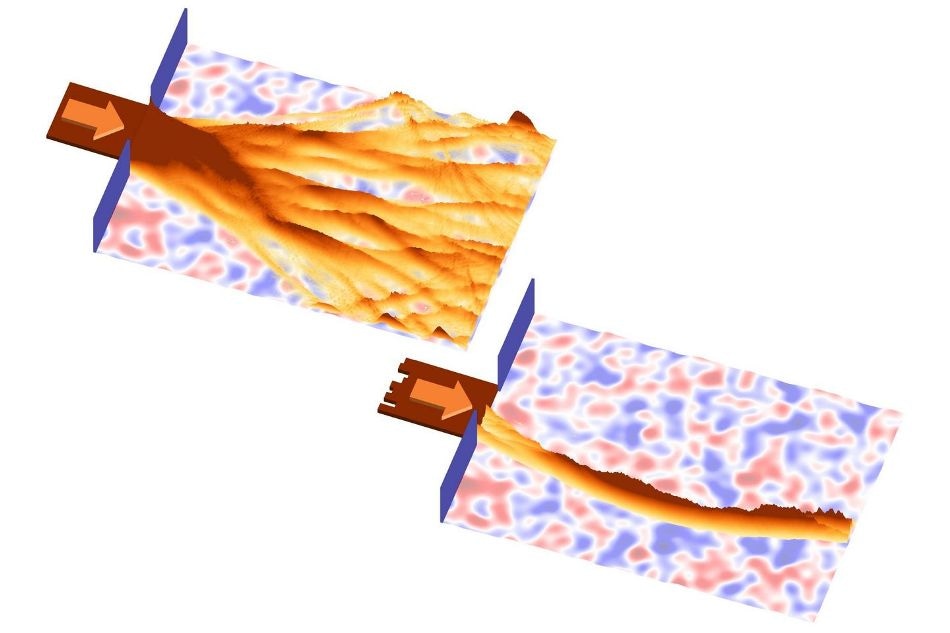Jun 25 2019
Waves do not always distribute uniformly into all directions, but can create a notable “branched flow.” In order to control this phenomenon, a technique has now been devised at TU Wien (Vienna).
 Controlling branched flow. Top figure: A light wave gets injected into a disordered, irregular environment and splits into several branches. Bottom figure: Shaping the wave at the input (left) makes the wave travel along only one single pre-selected branch, instead of splitting up into many. (Image credit: TU Wien)
Controlling branched flow. Top figure: A light wave gets injected into a disordered, irregular environment and splits into several branches. Bottom figure: Shaping the wave at the input (left) makes the wave travel along only one single pre-selected branch, instead of splitting up into many. (Image credit: TU Wien)
The light wave of a laser beam propagates in an absolutely straight line in free space. However, under particular conditions, the behavior of a wave can be much more intricate. When there is a disordered, irregular environment, an extremely unusual phenomenon takes place: An incoming wave is divided into many directions and it branches in a complicated manner, reaching some places with high intensity, while nearly avoiding others completely.
This type of “branched flow” was first noticed in 2001. Researchers at TU Wien (Vienna) have currently devised a technique to utilize this effect. The basic concept of this new technique is to transmit a wave signal solely along one single pre-selected branch, such that the wave is barely detected in any other place. The outcomes have now been reported in the journal PNAS.
From Quantum Particles to Tsunamis
Originally, this effect was discovered when studying electrons moving as quantum waves through tiny microstructures. Such structures, however, are never perfect and they always come with certain imperfections; and surprisingly, these imperfections cause the electron wave to split up into branches—an effect which is called branched flow.
Prof. Stefan Rotter, Institute of Theoretical Physics, TU Wien
Soon it appeared that this wave phenomenon not only takes place in quantum physics. Theoretically, it can take place with all kinds of waves and on entirely different length scales. For instance, if laser beams are transmitted into the surface of a soap bubble, they separate into numerous partial beams, similar to tsunami waves in the ocean.
Tsunami waves do not spread uniformly across the ocean; rather, they move in a complicated, branched pattern that is dependent on the random shape of the corrugated ocean sea bed. Thus, it is possible that a remote island is hit extremely hard by a tsunami, while the nearby island is only hit by much weaker wavefronts.
We wanted to know whether these waves can be manipulated in such a way that they only travel along one single selected branch, instead of propagating along a whole branched network of paths in completely different directions. And as it turns out, it is indeed possible to target individual branches in a controlled way.
Andre Brandstötter, Study First Author, TU Wien
Analyze and Adapt
In the new process, there are only two steps: First, the wave is permitted to branch out on all possible directions as normal. The wave is measured comprehensively at one of the sites reached with high intensity. The approach devised at the TU Wien can subsequently be employed to compute how the wave has to be shaped at the origin, in order to send it along a single chosen path while avoiding all other paths in the second step.
“We used numerical simulations to show how to find a wave that behaves exactly the way we want it to. This approach can be applied using a variety of different methods,” states Stefan Rotter. “You can implement it with light waves that are adjusted with special mirror systems or with sound waves that you generate with a system of coupled loudspeakers. Sonar waves in the ocean would also be a possible field of application. In any case, the necessary technologies are already available.”
This new approach allows all the various kinds of waves to be sent out along a single trajectory pre-selected from a complex network of paths. “This trajectory doesn't even have to be straight,” describes Andre Brandstötter. “Many of the possible paths are curved - the irregularities of the surroundings act like a set of lenses by which the wave is focused and deflected again and again.”
It is possible to send out even pulsed signals along these special paths in a manner that information can be sent in a targeted way. This ensures that a wave signal reaches accurately where it is supposed to be received; at other sites, it can barely be noticed, rendering eavesdropping much more hard.